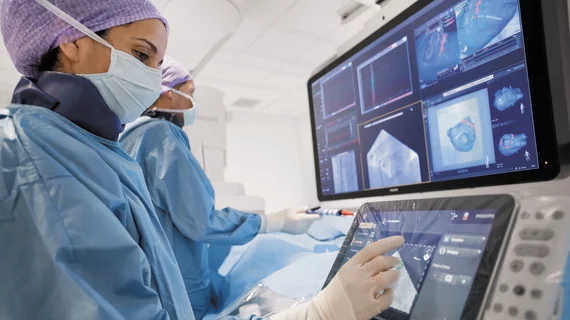Interventional radiology’s $68.4B inpatient footprint underscores ‘bedrock’ role in chasing the Triple Aim
Interventional radiologists treat about 1 in every 10 U.S. inpatients and with a sicker population sample, account for nearly one-fifth of all such healthcare costs, according to an analysis released Wednesday.
The subspecialty represented 18.4% ($68.4 billion) of adult inpatient healthcare spending in 2016 alone, highlighting IR’s pivotal role in reducing costs and bolstering outcomes, Stanford experts wrote in JACR. This role will only continue to grow as the population ages, with the average inpatient requiring interventional services trending older at 62.8 years, compared to 57.1 overall.
“As payers and policymakers articulate the Triple Aim, including lowering the per capita cost of healthcare, IR must play a central role in discussions of healthcare policy and funding,” Soleil Shah, an MD candidate at the Stanford University School of Medicine, and colleagues wrote Sept. 9. “Moreover, as the common denominator, IR should lead the charge that defines, measures and makes transparent the cost per capita for this complex group of patients.”
To reach their conclusions, Shah et al. analyzed the National Inpatient Sample database for 2016 and pinpointed all adults who underwent a routine image-guided procedure that year. All told, about 2.3 million out of 29.7 million (or 7.8%) had at least one such service. Along with being older, this patient population also trended sicker and logged a higher inpatient mortality of 8.2% compared to 1.7% in the non-IR population.
Interventional radiology patients represented just 7.8% of all admissions that year and yet tallied 18.4% of costs. They had a roughly three times higher mean hospitalization cost when compared to other inpatients—at $29,402 versus $11,062—which persisted even when controlling for age and other factors, Shah and colleagues reported. Lengths of stay were also about 2.5-times greater.
And certainly, there is opportunity for growth, the team noted. Currently, only about 62% of rural hospitals even offer IR services compared to 95% in urban settings. Plus, using image-guided, minimally invasive services as a substitute for surgery could offer cost savings by both decreasing therapy expenses and reducing hospital stays, they added.
“IR serves as the bedrock for decreasing waste in the system by delivering cost-effective and efficient care by reducing labor, nonlabor (expendables), and overhead expenses,” the research team argued. “By increasing availability, IR can decrease overall LOS, especially in resource- and cost-intensive areas such as intensive care units.”
Read more of the analysis in the Journal of the American College of Radiology here.

